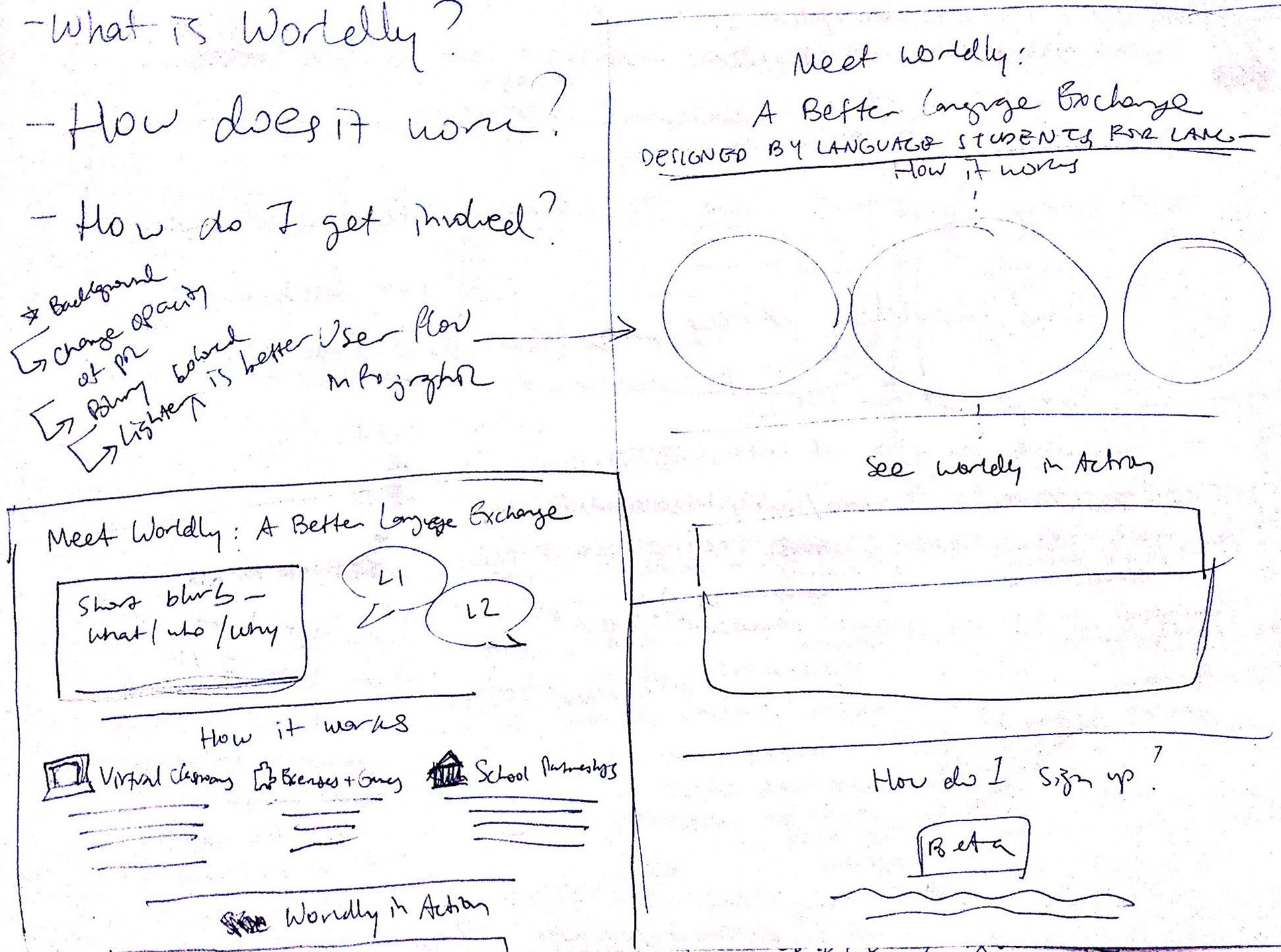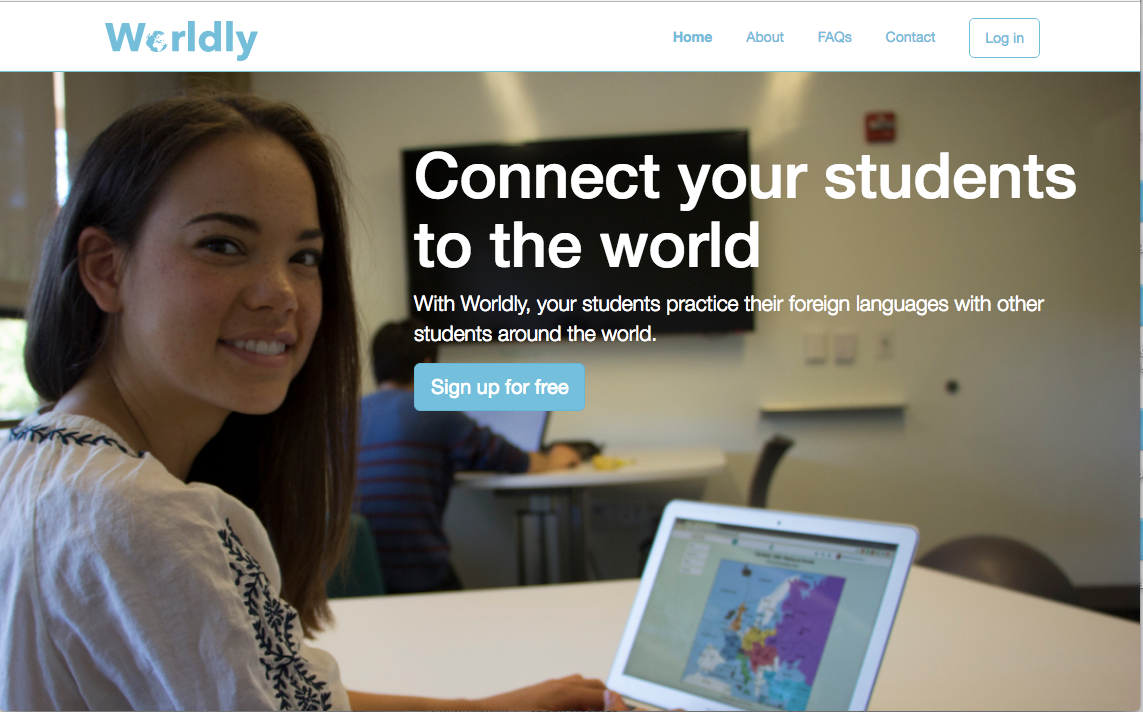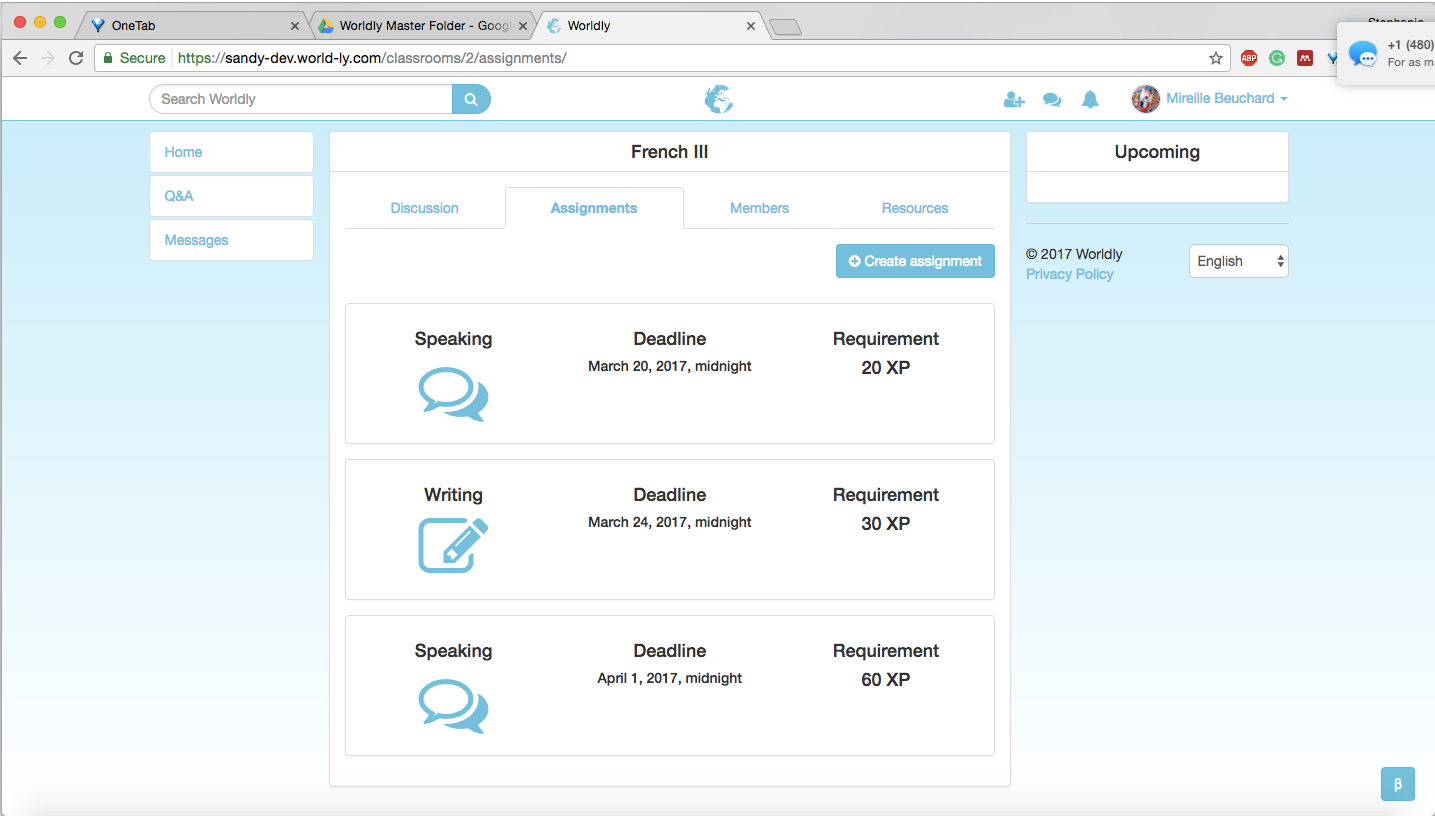Worldly Language Services, LLC
How I built an edtech software-as-a-service startup.
Goal: Turn an idea for a gamified, online language exchange to help students practice speaking foreign languages into a business.
My role: Part of a three-person co-founding team, leading design and operations
Timeline: 2 years
My wins: Gaining schools’ support for our beta prototype, developing my design and business acumen as a undergrad, meeting founders, advisors, and potential funders who taught me more than I can fit into a portfolio.
Final video for Product Design Capstone
Overview
This is the story of how I started a company. I consider this project emblematic of who I am as a designer for three key reasons:
1. Impact: I designed a usable product that solved a real need, winning enthusiastic supporters.
2. Growth: My experience with Worldly ran parallel to my undergraduate education in Product Design. I went from introductory classes in design thinking to advanced needfinding, creating responsive UI, writing product requirement documents for a web platform, and operating as an entrepreneur.
3. Resilience: This endeavor cemented my confidence in an iterative creative process which, by nature, forces you to learn from things that didn’t work, reform ambiguity or lack of expertise into driving questions, and exercise methods of analysis to find strong answers.
Process
In the spring of 2016, a friend from youth orchestra reached out to me with an problem he’d been thinking about:
How might we use online tools to accelerate the conversational fluency of students studying foreign languages in a way that is effective, inexpensive, and safe?
I was captivated by the challenge and knew the exact pain points from studying Chinese since the 8th grade and floundering to improve my speaking skills outside of the classroom. I was buoyed by seeing the initial working prototypes my friend and a few of his fellow Harvard CS classmates had already made for games that allowed students to simultaneously practice speaking a foreign language and help another student learn their own. I assumed this level of progress indicated sure success — rookie mistake.
Prototype of Catchphrase, UI in progress
Alpha prototype of Diplomacy from a student's view
Building the Platform
A few months in, the other CS students decided to pursue other projects, leaving only my friend as the developer, one of his friends who was a business student in France as our business manager, and me as our designer. Our eventual aim was to sell Worldly as a software subscription to schools. But, with little knowledge of how to get to that point, we focused our efforts internally on building the product. We envisioned a platform targeted toward intermediate-and-above language learners with authenticated logins for teachers and students to play games, track progress, use Q&A forums, chat, the works!
As a complete web design novice, I started by sketching wireframes, with first drafts of copy text as well as user flows, and sending them to our developer.

Student portal view with tabs

Teacher analytics view

Beta interest signup

About page

Teacher's journey
After learning how to use Photoshop and Illustrator, I transitioned to sending mockups instead of hand sketches. (I had no idea about tools like Sketch, Invision, or Figma yet.) I also created our site’s icons.


In the end, it took us about a year to build the full platform. We had a marketing website, real and non-real time games, messaging, and profiles — all translated in the three languages our founding team spoke fluently: English, Spanish, and French. And, two of our home classrooms were helping us test it out. A French class in Washington, DC, and an English class in Paris, both with high school level students in their second or third years of language learning.

Landing page with original photography

Teacher portal with view of assignments

Student profile

Beta interest signup
Building the Business
With about 30 students total spread across time zones, we were only able to get a little traction with games and activities. The time zone difference made it near impossible to do real-time games like Catchphrase. There were too few students to create a really engaging experience on the Q&A forums or for a multiplayer game like Diplomacy. We realized we had to get serious about scaling.
We worked our university networks to meet with advisors, mentors, and investors. Many believed in our team and our idea, and all contributed valuable perspective. We applied to startup accelerators, incubators, and pitch competitions, ending up getting accepted to Cardinal Ventures, placing among the top 10% of applicants to YCombinator, and finishing in the finals of the BASES 100k Startup Pitch Challenge. Said pitch below!
I took on the role of COO and Lead Designer by my senior year where Worldly became my capstone project and two of my Product Design classmates joined the team. I also worked on marketing; some efforts more successful than others. Direct outreach through Facebook groups, Twitter, or talking to companies we admired, in this instance, generated far more leads than A/B testing ad campaigns on Facebook (in hindsight, this was because our target audience characteristics were too broad).

Info sheet for teachers

Twitter mentions and supporters
Starting Over, Getting Better
As part of the capstone project requirements, we had to start the design process from scratch. As we’d been so focused on figuring out if we could build the product up to that point, we hadn’t taken a critical look at who we were trying to build for. Enter: needfinding.
My capstone team and I began our design research by talking to as many prospective users as possible. We spoke to language students, teachers, and principals from elementary school to college, from German to Mandarin. We were able to prove that conversational fluency was the hardest aspect to master in a foreign language, even with excellent teachers. However, we disproved the assumption that our product wouldn’t serve beginning-level language learners. Beginners have the greatest need to build confidence speaking in order to stay motivated to keep learning, and Worldly offered a way to practice in a safe environment with peers, which is essential for effective practice. We also found that what students and teachers valued most in a language exchange was not fancy games, it was simply access to native speakers, even better if they are close to the same age.
With a reframed value proposition, we designed and built two games for beginners that could be completed asynchronously (we had learned our lesson about working around time differences, too). One a video exchange exercise called Scripted, another a guessing game called “What Am I?”. We tested the former with an English Class in Mexico City and a Spanish class in Palo Alto, where students across classrooms partnered up to complete the game and give one other pointers on writing and pronunciation.
A tutorial video for "What Am I?", a guessing game via video exchange
Outcomes
We received interest from over 70 schools across the world to participate in our beta test.
Unfortunately, we were not in a financial position to continue Worldly after graduation, so we disbanded the summer of 2018. While Worldly did not ultimately succeed, looking back, it is without a doubt a personal success. My ruthless optimism, relentless seeking of opportunity, and being unafraid to ask for advice meant I left the company armed with a wealth of knowledge. I was able to form a network of supporters and expert coaches who allowed me to go from web design newbie to pitching a digital product I designed to hundreds of investors. I added skills to my designer's tool belt and learned a lot about managing time, shoestring budgets, people, and conflict.
Also, some pretty sweet but short-lived business cards.